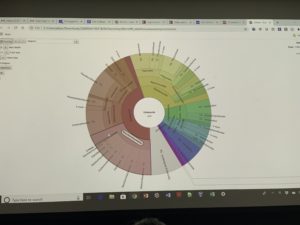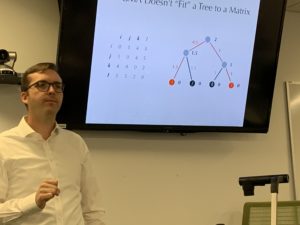Hello everyone I just had a wonderful third week at my computational biology internship at CMU.
I’m really excited to tell you guys about everything that I learned, but first there’s a point of particular interest. The my group under Josh Kangas may have discovered a new bacteria! One of the other interns had a small red colony on their growth plate and they decided that it was the most interesting thing that they had so they sent it off for single gene sequencing. This essentially means that instead of sequencing the entire DNA of an organism (which can be expensive and time consuming) you only sequence a single gene and then decide if you want to look into it further. In our case we sequenced the 16s gene which is common to nearly all bacteria because it is very important for cell replication. Basically everything in a microbiome has it, but it still has enough variability to tell us what an organism is most of the time. We discovered that our little red dot’s 16s gene is very similar to a 16s genome that was sequenced before, but that it could be an entirely new organism and even if it isn’t sequencing the entire genome could very well lead to a paper. That means that I and all of the other high schoolers here could have their names on a research paper. As I’m sure you are well aware by now I’m very excited about this prospect.
In other news this week saw me learning about the hugely important field of metagenomics. It essentially allows you to sequence every scrap of DNA in a sample and figure out what all the organisms in said sample are. This can tell you tons about the health of an ecosystem. For example in our samples from the rivers throughout Pittsburgh there were a number of organisms with genes coding for arsenic, lead or antibiotic resistance and many others that are found in human feces. Our conclusion from that was broadly: don’t swim in Pittsburgh rivers, but because we took data from different seasons and locations we can also figure out more specific information like when the rivers are most dangerous to public health and roughly where a lot of the contamination is coming from. Additionally, it can allow you to create genetic trees to see how different organisms are related to each other and how life has evolved over time. Metagenomics presents a lot of complicated computational problems, but the data that it can provide is really useful and it’s a very useful tool in the modern biologist’s arsenal.
This week was also a great time with my friends as we ate food played games together and laughed (one day where a bunch of us went to the university center to play squash was particularly memorable) , but it was also somewhat sad. Several of the summer programs at Carnage Mellon ended over the weekend and a lot of kids the same age as myself left. The goodbyes were sad, and everyone woke up far to early to see their friends off, but I know that I will treasure our shared time together for many years to come.
Looking towards the future, next week has the potential to be the most interesting so far. I will be working directly with Josh to break in and test the newest microscope on campus with a price tag of roughly half a Million dollars. It’s hard to imagine being one of the first people to utilize a machine that costs so much, but this internship is filled with surprises, and I’ll hopefully fill you in on how that goes in my next blog. Bye!



Josh,
It warms my heart to read about your excitement in learning. Grandpa would so enjoy your blog!
Josh:
I’m blown away by the sophistication of the wonderful experiences you are having. I hope your name will appear on that research paper! As you know, I’m a fan of “big science” and it’s great to see your enthusiasm for scientific exploration!
From Dr Seuss
Don’t cry it over
Smile t hat it happened
Sounds like you’re having a great time and learning a lot! Can’t wait to hear about next week.